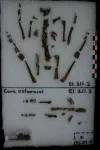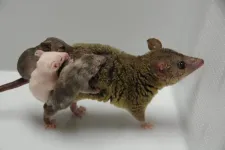(Press-News.org) Domesticated rabbits come in all sizes and colors, including tiny Netherland Dwarfs, floppy-eared French lops, Flemish Giants, and fluffy Angoras.
These breeds belong to Europe's only rabbit species, originally limited to the Iberian Peninsula and Southern France and used for meat and fur since the last Ice Age, culminating in domestication about 1,500 years ago.
The Americas, on the other hand, have many rabbit species with ranges throughout both continents. The archaeological record shows rabbits were used as extensively in the Americas as they were on the Iberian Peninsula, with clear archaeological evidence that rabbits were being deliberately raised. Why, then, were rabbits domesticated in Europe and not the Americas?
Recent work by archaeologists Andrew Somerville of Iowa State University and UC Riverside's Nawa Sugiyama found a simple answer: European rabbits live readily in large social groups while American cottontail rabbits do not. The less social nature of American cottontails combined with greater species diversity created a situation where rabbit husbandry did not lead to domestication.
Sugiyama looked to Teotihuacan, a major city in Mexico about 2,000 years ago, where cottontail rabbits comprised 23% of the animal remains during the Classic period. This was more than any other animal used for meat, including wild deer, as well as domesticated turkeys and dogs. The proportion of rabbit bones increased toward the city center, suggesting they were probably being raised, not hunted.
Rabbits were buried at the Sun and Moon Pyramids and are found in the stomach contents of sacrificial carnivores, such as eagles and pumas. Rabbit bones found in the carnivore stomachs contain a type of carbon that indicates a diet unusually rich in corn or cactus, suggesting human-raised rabbits had, in turn, been fed to the carnivores.
"The rabbits were probably fed corn, but the carbon isotopes don't distinguish between corn and cactus, so we can't say for certain," Sugiyama said.
Moreover, 46% of the animal bones excavated in one apartment compound were from rabbits that had been fed a similar diet of agricultural crops, and the amount of phosphate in the floor of one room indicates a location where rabbits urinated and were probably housed. A stone statue of a rabbit was also found in the complex's central plaza, reinforcing the importance of rabbit husbandry to the residents.
A thousand years later, the 16th century Spanish conquistador Hernan Cortez described the sale of rabbits at the Aztec marketplace of Tlateloco. Over at least a millennia of husbandry and extensive use for food, fur, and ritual, however, the rabbits of Mexico did not become domesticated -- a mutualistic, multigenerational relationship characterized by human-controlled reproduction.
To understand why, Somerville compared the behavioral ecology of European rabbits and American cottontails against criteria that "prime" or preadapt animals for domestication. Animals that have been domesticated usually live in groups with resident males. They also have young that imprint easily and require parental care, a promiscuous mating system, tolerance for a wide variety of environments, and low reactivity to humans.
European and American rabbits were similar across all criteria except social behavior. European rabbits live in underground family burrows, called warrens, of up to 20 individuals that include males, who defend their breeding territory from other males. Warrens made it easy for people to locate and manage wild rabbit populations, then mimic those conditions in captivity, where rabbits readily reproduced.
American cottontails, on the other hand, are solitary, live entirely above ground, and tend to fight in enclosures together. Males do not defend a breeding territory and pursue more opportunistic mating strategies.
Somerville and Sugiyama conclude that their solitary nature, tendency to fight in enclosures, dispersed territories, and less predictable mating systems made it possible to raise rabbits without forming the kind of mutual relationship that would eventually give humans enough control over a species to direct its evolution. Greater species diversity also made it less likely that any one of them would become domesticated.
INFORMATION:
The open-access paper, "Why were New World rabbits not domesticated?" is published in Animal Frontiers and available here.
A new University of Chicago study has found that the drug masitinib may be effective in treating COVID-19.
The drug, which has undergone several clinical trials for human conditions but has not yet received approval to treat humans, inhibited the replication of SARS-CoV-2 in human cell cultures and in a mouse model, leading to much lower viral loads.
Researchers at UChicago's Pritzker School of Molecular Engineering (PME), working with collaborators at Argonne National Laboratory and around the world, also found that the drug could be effective against many types of coronaviruses and picornaviruses. Because of the way it inhibits replication, it ...
Older people appear to have fewer antibodies against the novel coronavirus, a new laboratory study from Oregon Health & Science University suggests.
Antibodies are blood proteins that are made by the immune system to protect against infection. They are known to be key players in protection against SARS-CoV-2 infection.
The study published today in the Journal of the American Medical Association.
"Our older populations are potentially more susceptible to the variants even if they are vaccinated," said senior author Fikadu Tafesse, Ph.D., assistant professor of molecular microbiology and immunology in the OHSU School of Medicine.
Tafesse and colleagues emphasized that even though they measured diminished antibody ...
The average American spends 5 days each year in line by some estimates. Many of these lines are for things like a cup of coffee, movie theater tickets or a ride on the newest roller coaster, but for some the wait is for something far more pressing -- a new kidney.
In South Carolina, the average time spent on a waitlist for a kidney transplant is 42 months, but according to a recent paper in JAMA Surgery, changes to the U.S. kidney allocation system could result in reduced access to kidney transplants and longer times spent in line.
"At face value, the changes in the allocation system seem quite appropriate," said Derek DuBay, M.D., director of ...
Common yeast are able to adapt and thrive in response to a long-term rise in temperature by changing the shape, location and function of some of their proteins. The surprising findings demonstrate the unappreciated plasticity in the molecular and conformational level of proteins and bring the power of molecular biology to the organismal response to climate change. Results from the Zhou lab at the Buck Institute in collaboration with the Si lab from the Stowers Institute are published in Molecular Cell.
Temperature is an unstable parameter in the wild, affecting almost ...
Little is known about the weather at night on Venus as the absence of sunlight makes imaging difficult. Now, researchers have devised a way to use infrared sensors on board the Venus orbiter Akatsuki to reveal the first details of the nighttime weather of our nearest neighbor. Their analytical methods could be used to study other planets including Mars and gas giants as well. Furthermore, the study of Venusian weather granted by their methods could allow researchers to learn more about the mechanisms underpinning Earth's weather systems.
Earth and Venus ...
Researchers at the RIKEN Center for Biosystems Dynamics Research (BDR) have succeeded in creating the first genetically engineered marsupial. This study, published in the scientific journal Current Biology, will contribute to deciphering the genetic background of unique characteristics observed only in marsupials.
Genetically modified animals, particularly mice and rats, are extremely important tools for researching biological processes. For example, researchers often silence genes to find out what their normal functions are. Since marsupials have unique characteristics, studying them requires developing ...
During cell division, chromosomes are duplicated and separated so that one copy of each chromosome is inherited by each of the two emerging daughter cells. Correct distribution of chromosomes requires high accuracy and defects in this process can cause aberrant distribution of chromosomes and facilitate cancer development. By analyzing the structure of the protein responsible for chromosome separation, an international team, led by scientists from the University of Geneva (UNIGE), has shed light on the mechanisms controlling this essential player in cell division. This work is published in the journal ...
MIT physicists have observed signs of a rare type of superconductivity in a material called magic-angle twisted trilayer graphene. In a study appearing in Nature, the researchers report that the material exhibits superconductivity at surprisingly high magnetic fields of up to 10 Tesla, which is three times higher than what the material is predicted to endure if it were a conventional superconductor.
The results strongly imply that magic-angle trilayer graphene, which was initially discovered by the same group, is a very rare type of superconductor, known as a "spin-triplet," that is impervious to high ...
What The Study Did: This study at an institution of higher education in Colorado evaluated the association between self-reported protective behaviors and how common SARS-CoV-2 infection was among essential in-person employees during the first six months of the COVID-19 pandemic in the United States.
Authors: Tracy L. Nelson, M.P.H., Ph.D., of Colorado State University in Fort Collins, is the corresponding author.
To access the embargoed study: Visit our For The Media website at this link https://media.jamanetwork.com/
(doi:10.1001/jamanetworkopen.2021.16543)
Editor's Note: The article includes conflict of interest and funding/support disclosures. ...
What The Study Did: In this analysis of the 2015 U.S. Transgender Survey, gender-affirming hair removal procedures were associated with lower odds of past-month severe psychological distress, past-year smoking and past-year suicidal ideation.
Authors: Michelle S. Lee, B.A., of Harvard Medical School in Boston, is the corresponding author.
To access the embargoed study: Visit our For The Media website at this link https://media.jamanetwork.com/
(doi:10.1001/jamadermatol.2021.2551)
Editor's Note: The article includes conflicts of interest ...




